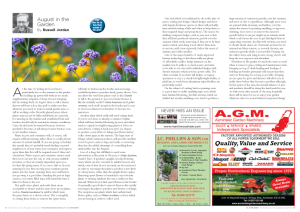
At the time of writing we’ve not had a particularly hot or dry summer so the garden is holding up pretty well without too much supplementary irrigation (I hope I’m not tempting fate by writing that!). In August there is still a chance that we will have a hot, dry, spell so make sure that whatever you need, to water essential garden areas, is still in working order. Recently planted areas, where plants may not yet be fully established, are a priority for watering in dry weather and established beds and borders should only be watered in extreme conditions. Grass should never be watered because, however parched it becomes, it will always bounce back as soon as wet weather returns.
Plants in pots and containers will, of course, still require artificial watering unless there is a really decent amount of natural rainfall. If you are going on holiday this month then it’s probably worth finding a trusted neighbour to at least water your containers and impress upon them that this will be required even if there isn’t a heatwave. Plants in pots and containers cannot send their roots out into the soil, to seek out any available moisture, so they are entirely dependent upon you for their life giving water. If no-one is able to do your watering for you then moving your container grown plants into the shade, watering them very well before you go away, is a good idea. Standing the pots in large saucers, or in water filled trays, will extend the time it takes for them to dry out.
Dry spells stress plants and make them more susceptible to disease and this may show up on plants, such as Knautia macedonica, by mildew which turns the green leaves to a silvery colour. This is unsightly so cutting them down, to remove the spent stems, will help to freshen up the border and encourage established plants to produce fresh, green, shoots. You can allow the seed from plants such as this Knautia to fall to the ground, as you cut it back, because it, like the similarly useful Verbena bonariensis and Lychnis coronaria, seeds itself around in the border and is easy to weed out whenever it threatens to become too numerous.
Another plant which really will need cutting back, if you’ve not done so already, is catmint (Nepeta) which will have finished flowering by now and which tends to squash its neighbouring plants if left to its own devices. Cutting it back now gives it a chance to produce a new flush of foliage and flower before it dies down again in the autumn. The large mats of foliage, which catmint produces, will provide excellent cover for pests, such as slugs and snails, so removing them has the added advantage of controlling these undesirables into the bargain.
Less of a thug, but still likely to need some intervention at this point of the year, is Stachys byzintina, ‘Lamb’s Ears’. It produces upright, woody, flowering stems which can also succumb to mildew by now and which, even if they do not succumb, are best removed in order to encourage the plant to produce a new flush of silvery leaves, rather than the upright flower spikes. Removing spent flowers is beneficial to most border plants so treating Stachys in this way is really not that unusual. Wherever you find spent flowers in the border it’s generally a good idea to remove them as this usually encourages the plant to produce new flowers or foliage. The exceptions are plants which have architectural flower spikes, such as Phlomis russeliana, or those which you are leaving in order to collect seed.
One task which it is traditional to do at this time of year is cutting yew hedges. Mixed hedges and those with largely deciduous species in them will probably have needed cutting a little and often to keep them to their required shape and proportions. The reason for tackling evergreen hedges, such as yew, now is that they will have produced extension growth over the summer which needs removing, if they are to be kept under control, and doing it now allows them time to recover, with some regrowth, before the onset of autumn and colder weather.
One of the major benefits of much improved battery technology is that there really are plenty of affordable cordless hedge trimmers on the market now. It really is so much easier, and safer, to be able to cut even well established hedges with electric trimmers which need no power cable. The other essential, if you have tall hedges or topiary specimens to cut, is a sturdy but lightweight ladder, or platform, to work from; aluminium tripod ladders are particularly useful.
On the subject of cutting back or pruning, now is a good time to tackle rambling type roses which have finished flowering. Just like wisteria, which we tackled last month, rambling roses tend to produce a large amount of extension growth, over the summer, and most of this is superfluous. Although most roses are pruned while dormant, and leafless, over the winter the reason for pruning rambling, or vigorous climbing, roses now is to remove the excessive growth before it can get caught up in autumn winds which could cause the rose to get dislodged from its supporting structure. Just like with wisteria, you need to decide which stems are ‘structural’ and need to be retained and then remove, or severely shorten, any extension growth which is not needed. Pruning out the oldest stems and tying in new, strong, shoots will keep the rose vigorous and abundant.
Elsewhere in the garden it’s much the same as usual when it comes to grass cutting and maintenance tasks. Keeping on top of dead-heading and feeding of bedding and tender perennials will ensure that they carry on flowering for as long as possible. Keeping an eye open for pests and diseases will allow you to tackle these before they become a problem although, by this point of the year, the natural balance of pest and predator should be doing the hard work for you. As with every other month of the year, hopefully there will be time for you to enjoy your garden whatever state it is in and whatever may need doing!




